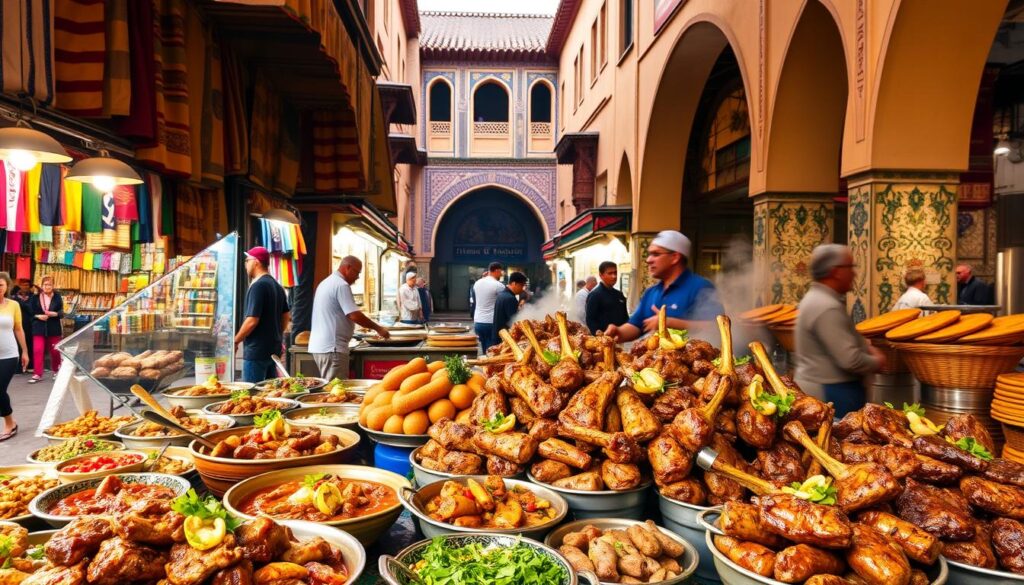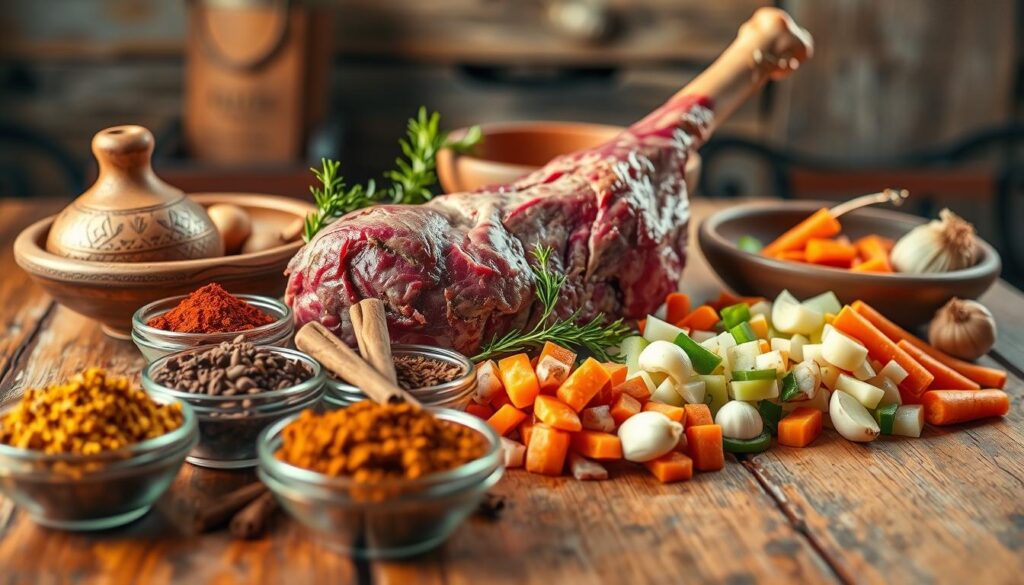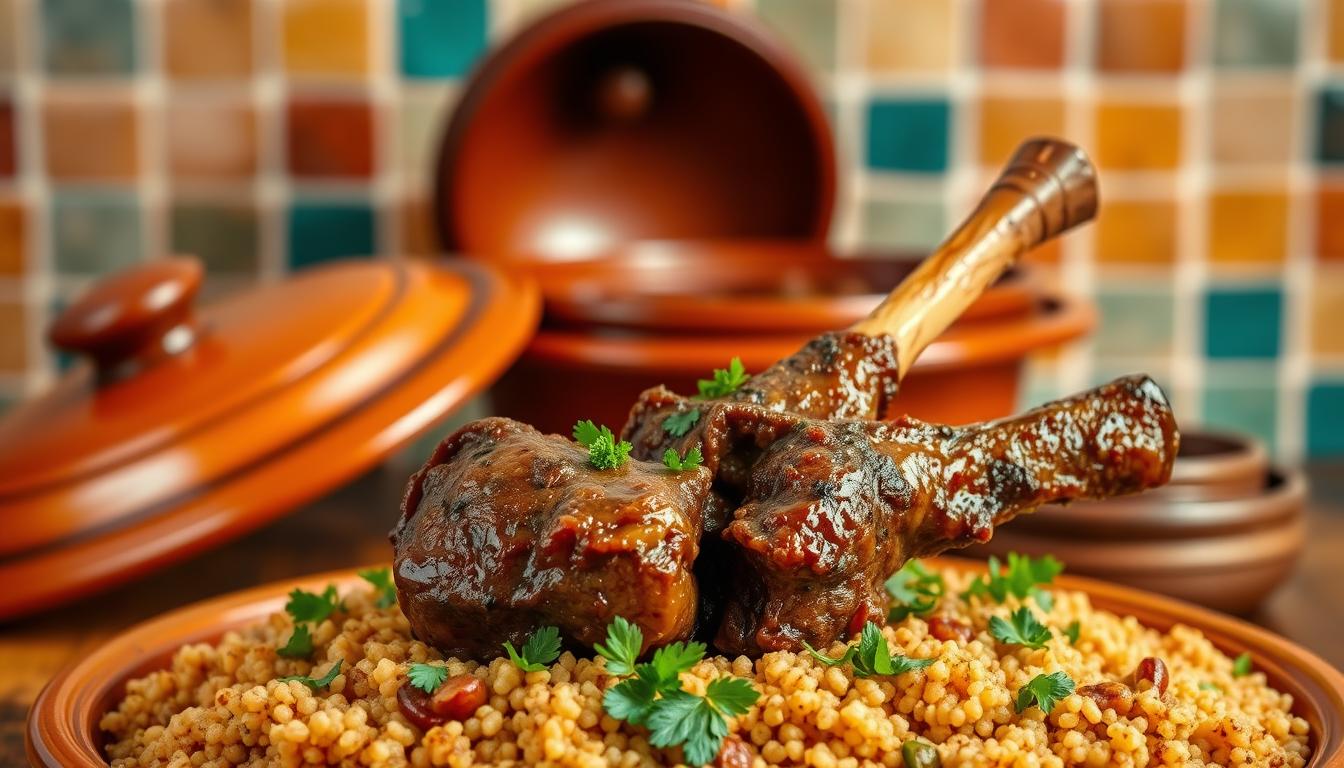Explore the world of Moroccan cuisine with a dish that warms your heart. Moroccan-Style Lamb Shanks are more than food. They are a blend of history and flavor, with spices and slow-cooked meat.
Starting your Moroccan food journey, you’ll see how these lamb shanks capture North African flavors. Every bite shares a story of old cooking methods. These methods turn simple lamb into a dinner highlight.
Picture tender lamb, flavored with spices like cumin, coriander, and paprika. It’s a taste of Morocco’s markets, right in your home.
Key Takeaways
- Moroccan-Style Lamb Shanks represent a pinnacle of slow-cooking techniques
- The dish combines traditional spices with tender, succulent lamb
- Preparation requires patience and attention to authentic cooking methods
- Each serving offers a rich nutritional profile with high protein content
- The recipe can be adapted for various cooking methods like oven and slow cooker
Introduction to Traditional Moroccan Lamb Cuisine
Moroccan cuisine is a colorful mix of Mediterranean flavors that has won hearts around the world. It’s a blend of North African traditions that turn simple ingredients into amazing dishes. This is thanks to the art of slow-cooking meat.

Moroccan cooking is all about mixing complex spices and techniques passed down through the ages. Slow-cooked meat is at the heart of this tradition. It shows the region’s deep respect for food.
Origins of Moroccan Lamb Dishes
Lamb has been a key part of Moroccan food for ages. These dishes come from Berber and Arab traditions, where cooking was seen as an art.
- Nomadic tribes developed unique cooking methods
- Preservation techniques were crucial in desert environments
- Spices became essential for flavor and food safety
Cultural Significance in North African Cooking
In North African cooking, lamb is more than just meat. It stands for hospitality, celebration, and community. Families come together to enjoy slow-cooked meals, sharing stories and keeping traditions alive.
The Art of Slow Cooking in Morocco
Slow cooking makes even the toughest meat tender and full of flavor. Tagines—traditional clay pots with conical lids—are key to Moroccan meat cooking. They let flavors simmer and intensify over time.
“In Morocco, cooking is a language of love, spoken through spices and patience.”
Moroccan cuisine, with its rich flavors and traditional techniques, inspires both home cooks and chefs. It encourages them to explore the rich world of slow-cooked lamb dishes.
Essential Ingredients for Moroccan-Style Lamb Shanks

To make authentic Moroccan-style lamb recipes, you need the right Mediterranean flavors. Start by knowing the key ingredients that make lamb shanks special.
Moroccan cuisine is all about its spices. These spices are crucial for creating deep, complex flavors in your dishes:
- Ground cumin – earthy and warm
- Coriander – citrusy and bright
- Cinnamon sticks – sweet and aromatic
- Paprika – for rich color and mild heat
- Turmeric – providing golden undertones
Preserved lemons and green olives add a tangy brightness to your lamb dishes. They are key to Mediterranean flavors. Choose high-quality, well-marbled lamb shanks for tender results.
Pro tip: If you cannot find preserved lemons, you can substitute fresh lemon zest and juice to capture a similar bright, acidic profile.
Your spice blend should have warmth, depth, and complexity. Add dried herbs like thyme and rosemary to your Moroccan spices. This mix will give your dish a rich flavor that feels like a trip to North Africa.
The Perfect Spice Blend: Ras el Hanout
Discover the secret to authentic Mediterranean flavors with Ras el Hanout. This magical spice blend turns simple dishes into amazing culinary experiences. It brings the essence of North African cuisine right to your kitchen.
Ras el Hanout means “top of the shop” in Arabic. It’s the best spice mix a merchant offers. Each blend has its own story of flavor and tradition.
Traditional Spice Components
A classic Ras el Hanout has a mix of spices that add depth and complexity:
- Cinnamon for warmth
- Cumin for earthiness
- Cardamom for subtle sweetness
- Ginger for brightness
- Turmeric for color and tang
- Paprika for mild heat
Creating Your Own Spice Mixture
Making your own Moroccan Spice Blend is easy. Start with high-quality whole spices. Toast them gently to release their oils. Then, grind them fresh for the best flavor.
Storage and Shelf Life Tips
To keep your spice blend fresh, store it in an airtight container. Keep it away from direct sunlight. Homemade spice blends stay flavorful for 3-6 months in a cool, dark place.
Selecting and Preparing Your Lamb Shanks
Choosing the right lamb shanks is key for tasty Braised Lamb dishes. Look for shanks that are rich in color and well-marbled. It’s best to pick lamb shanks that weigh about 1 pound each for perfect portions in your Moroccan-style recipe.
Before cooking, proper preparation is crucial. Follow these essential steps:
- Trim excess fat from the lamb shanks
- Pat the meat dry with paper towels
- Season generously with salt and pepper
- Allow the meat to reach room temperature before cooking
When selecting lamb shanks, consider these professional tips:
- Choose shanks with a deep, rich red color
- Look for consistent marbling throughout the meat
- Select shanks from the hind leg for maximum tenderness
- Ask your butcher for recommendations if uncertain
For the most authentic Moroccan experience, fresh, high-quality lamb shanks are essential. They make a memorable dish that will take your taste buds to North Africa.
Pro tip: Always purchase lamb shanks from a trusted butcher who understands quality meat selection.
The Art of Braising: Moroccan Techniques
Learning to braise lamb is a journey that turns tough cuts into tender delights. Tagine cooking is an ancient method that makes slow-cooked meat incredibly flavorful and soft.
When braising lamb, controlling the temperature is key. It’s all about keeping the heat low and steady. This lets collagen break down slowly, making the meat tender and easy to pull from the bone.
Traditional Braising Methods
Moroccan chefs have honed slow-cooked meat techniques over many years. They use:
- Earthenware tagines for even heat
- Cooking at low temperatures (around 325°F)
- Long cooking times of 2.5-3 hours
- Keeping an eye on moisture levels
Temperature Control Tips
To get perfect braised lamb, follow these steps:
- Start by searing the meat at high heat to seal in flavors
- Then, lower the temperature for slow cooking
- Keep the oven temperature consistent
- Use a meat thermometer to check the meat’s internal temperature
Achieving Perfect Tenderness
Success in braising comes from patience. Slow cooking breaks down tough fibers, turning lamb shanks into a dish that’s almost like butter. Remember, lamb shanks are tough cuts that need low, slow heat to become tender.
The secret to exceptional braised lamb lies in respecting the meat’s natural characteristics and allowing time to work its magic.
Moroccan-Style Lamb Shanks: Step-by-Step Recipe
Making Moroccan-Style Lamb Shanks needs patience and care. This recipe turns your kitchen into a North African feast. It uses tagine cooking methods.
Start by getting your ingredients for four servings:
- 3-4 lamb shanks (approximately 1¼ pounds each)
- 2 tablespoons olive oil
- 8 garlic cloves, minced
- 2 large tomatoes, chopped
- 1 large onion, diced
Make your spice mix with these important ingredients:
- 2 teaspoons ground cumin
- ½ teaspoon cinnamon
- ½ teaspoon turmeric
- ½ teaspoon ground coriander
The cooking steps are key. First, brown the lamb shanks for 6-8 minutes. This step adds a deep flavor. Then, cook your veggies and spices. This makes a fragrant base for your dish.
To get the best results, braise the lamb in the oven at 325°F for about 3 hours. This slow cooking makes the lamb tender. It’s a key part of Moroccan lamb recipes.
Pro tip: Let the lamb shanks rest for 10-15 minutes after cooking. This keeps them juicy.
Your dish will have about 255 calories per serving. It has 30g of protein and a mix of spices. These spices take you to Marrakech’s markets.
Complementary Side Dishes and Accompaniments
Make your Moroccan Cuisine experience even better by choosing the right sides for your lamb shanks. The perfect accompaniments turn a simple meal into a feast of Mediterranean Flavors. It becomes a true comfort food experience.
Your lamb shanks need amazing friends to bring out their rich, aromatic taste. Here are some delightful pairings to make your dish unforgettable:
Couscous: The Classic Base
Couscous is the perfect base for Moroccan lamb dishes. Here’s how to make it:
- Use fine-grain semolina for authentic texture
- Fluff with a fork to create light, airy grains
- Season with a pinch of salt and olive oil
Vibrant Vegetable Companions
Roasted vegetables bring color and nutrition to your meal. Try these traditional options:
- Honey-glazed carrots
- Spiced roasted zucchini
- Chickpea medley with cumin
Sauces and Garnishes
Add these flavor-enhancing elements to complete your dish:
- Harissa – a spicy North African chili paste
- Fresh herbs like cilantro and mint
- Toasted almonds for crunch
- Preserved lemon for a tangy twist
Pro tip: A sprinkle of fresh herbs can transform your lamb shanks from good to extraordinary!
Each element you choose will create a symphony of flavors. It celebrates the rich traditions of Moroccan Cuisine.
Wine Pairing and Serving Suggestions
Exploring Moroccan cuisine means finding the right wine for your lamb shanks. This can make your meal even better. The rich, spiced flavors of this comfort food need a wine that matches well.
Here are some top wine picks:
- Spanish Priorat – A strong red with lots of fruit flavors
- Syrah from California’s volcanic areas
- Grenache blends from Southern Rhône
- Bold Californian red wines with deep complexity
Choose a wine that balances the strong spices of the lamb shanks. Look for wines with a full body and moderate tannins. They should handle the dish’s bold flavors well.
Pro tip: Pick a wine you’d like to drink with your meal for the best taste.
To serve, place the lamb shanks on a big platter with fresh herbs. This creates a cozy, communal dining feel, like in Morocco. Pour your wine in big glasses to let its smells fully come out.
The right wine can turn a simple meal into a special journey through Moroccan cuisine.
Tips for Making Ahead and Storage
Preparing Moroccan-Style Lamb Shanks in advance is a big help for cooks and food lovers. These tasty slow-cooked dishes are great for meal prep and parties. They let you enjoy comfort food without the rush of last-minute cooking.
Proper Cooling Methods
When working with lamb recipes, keeping food safe is key. Here’s how to cool your dish right:
- Cool cooked lamb at room temperature within 90 minutes
- Use shallow containers to help meat cool faster
- Avoid leaving lamb at room temperature for extended periods
Reheating Guidelines
Reheating slow-cooked meat needs careful steps to keep it tender and flavorful:
- Remove lamb from refrigerator 30 minutes before reheating
- Use low, gentle heat to prevent drying out
- Ensure internal temperature reaches 165°F for food safety
- Add a splash of broth to maintain moisture
Freezing Instructions
Freezing is a great way to keep your lamb dishes fresh:
- Cooked lamb can be frozen for up to two months
- Store in airtight, freezer-safe containers
- Label containers with date and contents
- Avoid refreezing lamb after initial freezing
By using these storage tips, you can enjoy your Moroccan-Style Lamb Shanks easily and keep their flavor perfect.
Variations and Regional Adaptations
Exploring Moroccan cuisine shows a wide range of lamb recipes across regions. Your journey through Mediterranean flavors is full of taste and tradition.
Regional adaptations of Moroccan lamb dishes highlight the tradition’s incredible diversity. Some key variations include:
- Coastal regions often incorporate more seafood-inspired marinades
- Mountain communities use heartier spice blends with local herbs
- Urban centers create more refined, restaurant-style presentations
In rural Moroccan communities, lamb recipes reflect local ingredients and cooking techniques passed down through generations. Ras el Hanout spice blends might change subtly from village to village. This creates unique flavor profiles that tell a story of local heritage.
“Every region in Morocco tells its story through its lamb dishes” – Moroccan Culinary Tradition
Your home kitchen can try these variations by adjusting spice combinations, cooking methods, or side dishes. The key is to keep the essence of traditional Moroccan cuisine while adding your own touch.
- Experiment with different herb combinations
- Try alternative cooking techniques like pressure cooking
- Adapt side dishes to match local ingredients
Understanding these regional adaptations lets you see the depth and complexity of Moroccan lamb recipes. It goes beyond a single standard preparation.
Health Benefits and Nutritional Information
Moroccan-Style Lamb Shanks are more than just tasty. They are packed with nutrients. Each serving has about 450 calories, offering a lot of protein to support muscle health.
The spices in Moroccan lamb dishes are good for you. Cumin, turmeric, and ginger have antioxidants that fight inflammation. Green olives and fresh herbs add more nutrients, making it a balanced meal.
Slow-cooked meat is full of lean protein and minerals. You get 38 grams of protein, 20 grams of carbs, and 25 grams of healthy fats in each serving. This dish is rich in nutrients, supporting your health and pleasing your taste buds.
This comfort food is great for those watching their diet. It’s high in protein and fiber, with aromatic spices. It’s a flavorful, healthy meal that your body will thank you for.

